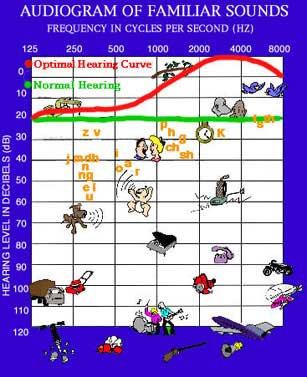If you’re concerned about your child’s hearing ability, the first port of call should be a screening hearing test and a visit to your G.P to check for any related medical conditions. It’s always preferable to have your child’s hearing screened promptly, so they can receive any help they need early on.
You know your child best. If you suspect a possible hearing loss, book a screening hearing test for your child today. The sooner a pass/fail screening result is established the better. Don’t wait up to six months for an appointment at your local public hospital.
Hearing loss doesn’t necessarily mean you can’t hear at all, or that sounds just aren’t loud enough. You might notice that your child doesn’t respond from a distance or that words don’t seem to be clear. Delays in speech and language development, as well as educational progress, can also be signs of a possible hearing loss.
The impact of hearing loss on a developing child is quite different from the effects of hearing loss that occurs in adulthood. Children use their hearing to learn about the world around them and develop communication skills.
Hearing loss can develop at anytime, even years after your child passed their newborn screening test.
The Audiogram
Pure tone audiometry involves listening to beeps across a range of pitches, or notes, and responding when the stimulus is heard. The examiner systematically finds the softest sounds the participant can hear across a range of frequencies and determines the Hearing Threshold – the softest sounds one can hear across the range of pitches that are important for speech understanding. The Hearing Thresholds are plotted on a graph called an Audiogram (below). Frequency pitch is measured in Hertz (Hz) and is plotted on the x-axis with low frequencies on the left increasing to high frequencies on the right (like a piano keyboard). Loudness (volume) is measured in decibels (dB) and is plotted on the y-axis, with very soft sounds at the top of the graph increasing to very loud sounds at the bottom.
Types of Hearing Loss
Here is some information on different types of hearing loss.
Temporary Hearing Loss
Some children develop temporary hearing loss generally from various Middle Ear conditions. A common cause of temporary hearing loss in children is ‘Glue Ear’ due to fluid in the middle ear (behind the ear drum). This may follow a cold/flu or other virus or respiratory infection. It may also sometimes occur ‘out of the blue’. If your child appears to have hearing difficulties for longer than one week, a screening test is recommended.
Some signs your child may be suffering with a hearing loss and or an ear infection or fluid in the middle ear (glue ear) are:
- Complaining of sore ears or aching ears
- Pulling at their ears or touching their ears more than normal
- Temperature/fever (with ear infection)
- Crying and cranky more than usual
- Not sleeping well
- Not responding to speech at soft levels
- Needing the volume up on the TV or radio
- Asking people to repeat
- Not responding when spoken to
- Has unclear speech and/or speak loudly
- Not speaking at the same level as other children of the same age
- Having difficulty learning to read or spell
- Parents/Grandparents are usually the first people to recognise a hearing problem
Permanent Hearing Loss
Some children gradually acquire a permanent hearing loss. This may occur anytime, even in adolescence. A child may be unaware of the hearing loss.
Your child’s hearing needs to be checked if your child is:
- Not hearing properly.
- Needing the TV or radio up loud.
- Has unclear speech and/or speak loudly.
- Not speaking at the same level as other children of the same age.
- Having difficulty learning to read or spell.
- Becoming disinterested or disruptive in class.
- Behavioural changes.
Hearing loss can be categorized by which part of the auditory system is damaged. There are three basic types of hearing loss: conductive hearing loss, sensorineural hearing loss, and mixed hearing loss.
Conductive Hearing Loss
Conductive hearing loss occurs when sound is not conducted efficiently through the outer ear canal to the eardrum and the tiny bones (ossicles) of the middle ear. Conductive hearing loss usually involves a reduction in sound level or the ability to hear faint sounds. This type of hearing loss can often be corrected medically or surgically.
Some possible causes of conductive hearing loss:
- Fluid in the middle ear from colds.
- Ear infection (otitis media).
- Allergies (serous otitis media).
- Poor eustachian tube function.
- Perforated eardrum.
- Benign tumors.
- Impacted earwax (cerumen).
- Infection in the ear canal (external otitis).
- Swimmer’s Ear (otitis ecxterna).
- Presence of a foreign body.
- Absence or malformation of the outer ear, ear canal, or middle ear.
Sensorineural
Sensorineural hearing loss (SNHL) occurs when there is damage to the inner ear (cochlea), or to the nerve pathways from the inner ear to the brain. Most of the time, SNHL cannot be medically or surgically corrected. This is the most common type of permanent hearing loss.
SNHL reduces the ability to hear faint sounds. Even when speech is loud enough to hear, it may still be unclear or sound muffled.
Some possible causes of SNHL:
- Illnesses.
- Drugs that are toxic to hearing.
- Hearing loss that runs in the family (genetic or hereditary).
- Aging.
- Head trauma.
- Malformation of the inner ear.
- Exposure to loud noise.
Mixed
Sometimes a conductive hearing loss occurs in combination with a sensorineural hearing loss (SNHL). In other words, there may be damage in the outer or middle ear and in the inner ear (cochlea) or auditory nerve. When this occurs, the hearing loss is referred to as a mixed hearing loss.


